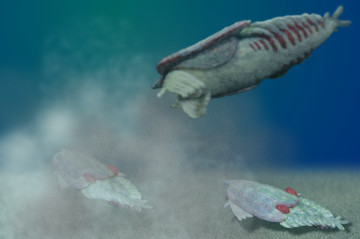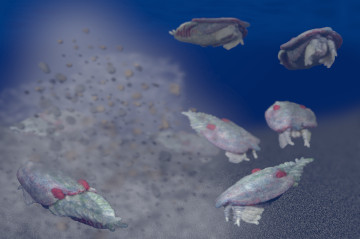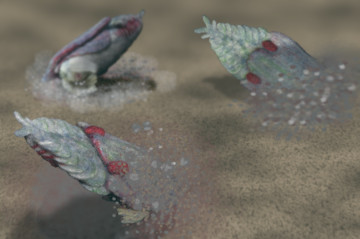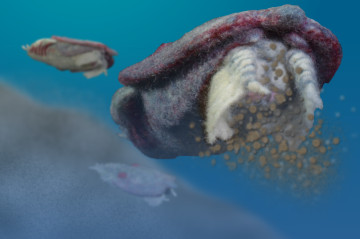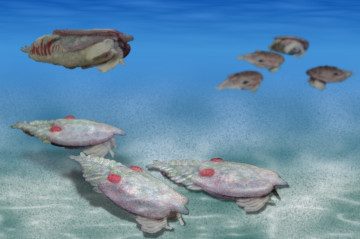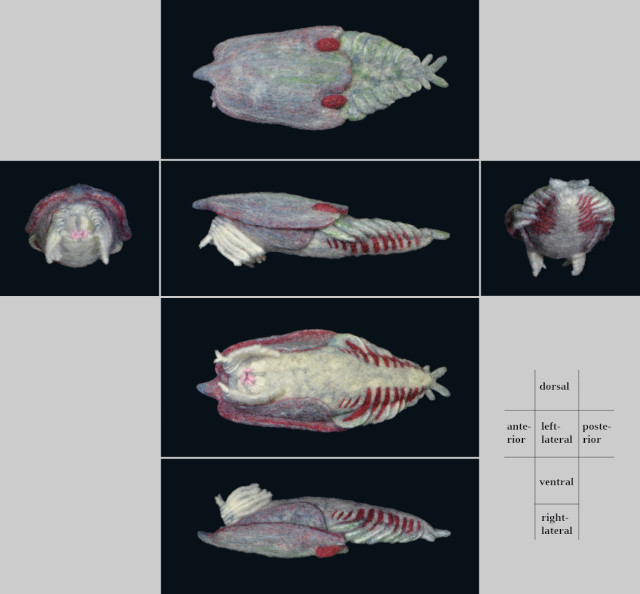Titanokorys gainesi
The largest Cambrian hurdiid, reaching 50 cm in length, Titanokorys gainesi is occurred from the Burgess Shale (the Middle Cambrian, 509 million years - 504.5 million years ago), British Columbia, Canada 1).
Owing to its large head shield (H-element), genus name "Titanokorys" is from "Titans", the giant deities of Greek myth and a greek word "Korys" meaning helmet; species name "gainesi" is named after Robert R. Gaines, an geologist and palaeontologist 1).
The head shield, consisting of a large ovoid-shape H-element and two drop-shaped P-elements, is approximately 27 cm, 20 cm in maximum length, respectively, then total length is estimated to reaching 50 cm 1).
The pair of P-elements are connected each other at an anterior narrow area 1).
Since Titanokorys has a pair of frontal appendages with endites having a large number of secondary spines, it appears a filter-feeder, that is, it had been ploughing and floating sediments and sifting micro-organisms from them 1).
However, there is an argument that Cambroraster were not suitable for ploughing sediment directly, and would have been a suspension-feeder 2). The frontal appendages of Titanokorys are resemble for ones of Cambroraster, so they may had not good at manipulating sediment directly.
Titanokorys and Cambroraster are found on the same bedding surfaces and have similar feeding apparatus (the frontal appendages and oral cone), though the shape of their carapaces and the body size of them are different 1). Accordingly, in spite of their competitive relation for benthic resource, they may had been co-existence, suggesting that the Cambrian sea-floor was rich environment so much 1).
Titanokorys is generally similar to Cambroraster, so both species may be dimorphism of a single species. But, based on rigorous compare on such as head shields, these are assigned to distinct species 1).
Created in January - March 2022.
References:
- Caron JB, Moysiuk J (2021) A giant nektobenthic radiodont from the Burgess Shale and the significance of hurdiid carapace diversity. R. Soc. Open Sci. 8: 210664. (DOI: 10.1098/rsos.210664)
- De Vivo G, Lautenschlager S, Vinther J. (2021) Three-dimensional modelling, disparity and ecology of the first Cambrian apex predators. Proc. R. Soc. B 288: 20211176. (DOI: 10.1098/rspb.2021.1176)
- Moysiuk J, Caron JB (2019) A new hurdiid radiodont from the Burgess Shale evinces the exploitation of Cambrian infaunal food sources. Proc. R. Soc. B 286:20191079. (DOI:10.1098/rspb.2019.1079)
- Liu Y, Lerosey-Aubril R, Audo D, Zhai D, Mai H, Ortega-Hernández J (2020) Occurrence of the eudemersal radiodont Cambroraster in the early Cambrian Chengjiang Lagerstätte and the diversity of hurdiid ecomorphotypes. [abstract] Geol. Mag. 157(7): 1200 - 1206. (DOI: 10.1017/S0016756820000187)

